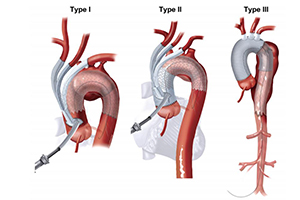Type I and Type II hybrid aortic arch replacement: postoperative and mid-term outcome analysis
Abstract
Background: Hybrid aortic arch replacement has emerged as a safe treatment modality for arch aneurysms, especially in patients of old age and with greater comorbid burden. We assessed our institutional outcomes in patients undergoing Types I and II hybrid aortic arch replacement.
Methods: From 2005 to 2012, 685 patients underwent thoracic endovascular repair (TEVAR), of whom 104 had hybrid arch repair (open + endovascular approach). 47 of these patients had treatment for aortic arch aneurysm ± proximal ascending aortic aneurysm. The hybrid repair entailed aortic arch vessel debranching and concomitant/delayed antegrade ± retrograde TEVAR stent grafting of the arch. Type III patients were excluded from the analysis. Data was prospectively maintained.
Results: 28 patients had Type I repair, 8 had Type II repair, and 11 had Type III repair. Mean age was 71±8 years. Primary aortic pathology was aneurysm (81%), followed by chronic arch dissection (11%). 14% of patients required reoperative cardiac surgery. Stent graft deployment rate was 100% after arch vessel debranching. Postoperative endoleak rate was zero. Average cardiopulmonary bypass time was 215±64 minutes, with crossclamp time of 70±55 minutes, and circulatory arrest time of 50±17 minutes. Paraplegia rate was 5.5% (n=2), with stroke rate of 8% (n=3) and renal failure rate of 3% (n=1) requiring hemodialysis. Inhospital mortality was 8% (n=3). Mean length of stay was 17.2±14 days.
Median follow-up was 30±21 months. Freedom from all-cause mortality was 71%, 60%, and 48% at 1, 3, and 5 years respectively. Aortic reoperation rate was 2.7% (n=1). No patient had Type I or III endoleak at follow-up. Freedom from mortality was improved in cases performed more recently (July 2008 to 2012) than during our early experience (2005 to June 2008) (81% versus 44% at 3 years, P=0.05).
Conclusions: Hybrid aortic arch replacement can be performed with good postoperative and midterm results in a cohort of old patients with significant comorbidity. With greater experience, early and midterm outcomes continue to improve. The hybrid arch technique may represent a technical advancement in the field of aortic arch surgery.
Cover






